Muchos usuarios de WordPress prefieren trabajar en sus sitios web utilizando un servidor local en su ordenador. Esto le permite trabajar en su sitio web en privado antes de hacer los cambios disponibles en línea.
Con el tiempo, tendrá que trasladarlo a un servidor en vivo para que sea accesible a los visitantes en línea. Esta transición es crucial para garantizar que el sitio web funcione correctamente en el sitio activo.
Hemos trabajado en muchos sitios web locales, así que tuvimos que aprender la forma más fácil de transferir contenidos a sitios web activos.
En este artículo, proporcionaremos instrucciones paso a paso sobre cómo trasladar WordPress de un servidor local a un sitio activo.
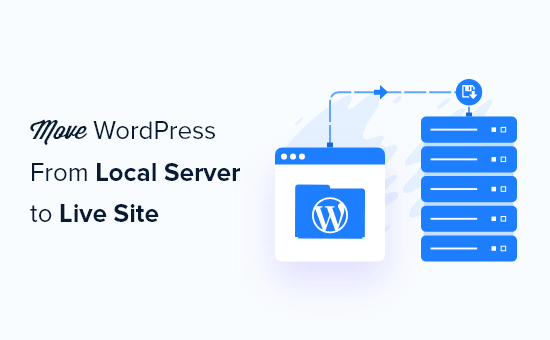
¿Por qué trasladar WordPress de un servidor local a un sitio activo?
Construir su blog de WordPress en un servidor local es una forma segura de probar los cambios en su sitio web sin afectar a los visitantes.
Cuando haya terminado de perfeccionar su sitio web, el siguiente paso es pasar de su servidor local a un sitio activo.
Vamos a mostrarle dos formas de trasladar su sitio de un servidor local a un sitio activo.
El primer método utiliza un plugin de migración de WordPress y se recomienda para principiantes.
En el segundo método, le mostraremos cómo trasladar manualmente WordPress de un servidor local a un sitio activo.
Puede elegir el método que más le convenga:
Antes de migrar su sitio WordPress
Para migrar WordPress de un servidor local a un servidor activo, debe tener en cuenta algunos aspectos.
En primer lugar, suponemos que tiene un sitio de WordPress ejecutándose en un servidor local (también llamado localhost) en su ordenador y que tiene pleno acceso al mismo.
A continuación, tendrá que tener un nombre de dominio y alojamiento web.
Hemos oído innumerables historias de principiantes que empezaron con proveedores de alojamiento web malos o gratuitos y se arrepintieron. Según nuestra experiencia, elegir el proveedor de alojamiento correcto es fundamental para el éxito de cualquier sitio web.
Para facilitarte la decisión, te recomendamos Bluehost. Son una empresa de alojamiento de WordPress recomendada oficialmente, y están dando a los usuarios de WPBeginner un descuento exclusivo + dominio y SSL gratis.
Básicamente, puedes empezar por tan sólo 1,99 $ al mes.
Si quieres una gran alternativa a Bluehost, puedes mirar Hostinger. También están ofreciendo un descuento exclusivo a los usuarios de WPBeginner con un nombre de dominio gratis.
Si puedes permitirte pagar un poco más, entonces comprueba SiteGround. También tienen una oferta especial para los lectores de WPBeginner.
Si necesitas ayuda para establecer tu sitio web, sigue paso a paso nuestra guía sobre cómo crear un sitio web.
Por último, necesitará un programa FTP y saber cómo utilizarlo para subir el sitio de su servidor local al sitio activo.
¿Preparado? Empecemos a migrar su sitio de WordPress.
Tutorial en vídeo
Si prefiere instrucciones escritas, siga leyendo.
Método 1: Transferir WordPress del servidor local al sitio activo utilizando un plugin de migración (recomendado)
Este método es más fácil y recomendado para principiantes. Vamos a utilizar un plugin de migración de WordPress para mover WordPress desde localhost a un sitio en vivo.
Paso 1: Instalar y configurar el plugin Duplicator
En primer lugar, debe instalar y activar el plugin Duplicator en su sitio regional. Para más detalles, consulte nuestra guía paso a paso sobre cómo instalar un plugin de WordPress.
Consejo profesional: También hay una versión pro de Duplicator que ofrece copias de seguridad seguras, almacenamiento en la nube, restauración fácil del sitio y mucho más.
Tras la activación, debe ir a la página Duplicator ” Copias de seguridad y hacer clic en el botón “Crear nueva”.
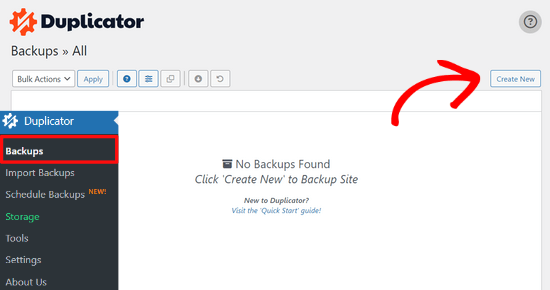
Aparecerá una pantalla en la que podrá asignar un nombre a la copia de seguridad.
A continuación, haga clic en el botón “Siguiente”.

Duplicator realizará ahora algunas pruebas para ver si todo está en orden.
Si todos los elementos están marcados como “Bien”, haga clic en el botón “Construir”.

Este proceso puede tardar unos minutos, dependiendo del tamaño de su sitio web. Debe dejar esta pestaña abierta hasta que finalice.
Cuando termine, verá las opciones de descarga de los paquetes “Instalador” y “Archivo”. Haz clic en el botón “Descargar ambos archivos” para descargarlos en tu ordenador.

El archivo “Archivo” es una copia completa de su sitio WordPress. Incluye todos los archivos del núcleo de WordPress, así como sus imágenes, subidas, temas, plugins y una copia de seguridad de su base de datos de WordPress.
El archivo “Instalador” es un script que automatizará todo el proceso de migración descomprimiendo el archivo que contiene su sitio web.
Paso 2: Crear una base de datos para su sitio web WordPress en vivo
Antes de que pueda ejecutar el instalador o subir el sitio web WordPress desde localhost a su servidor de alojamiento, necesita crear una base de datos MySQL para su nuevo sitio web en vivo.
Si ya ha creado una base de datos MySQL, puede omitir este paso.
Para crear una base de datos, debe visitar el Escritorio cPanel de su cuenta de alojamiento. A continuación, localice la sección “Bases de datos” y haga clic en el icono “Asistente para bases de datos MySQL”.
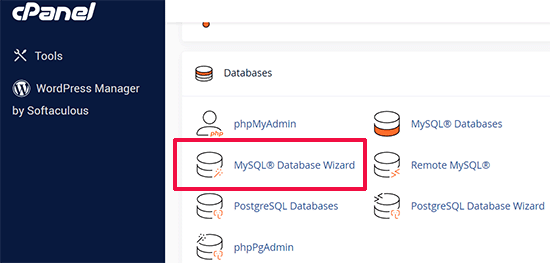
En la pantalla siguiente, hay un campo para crear una nueva base de datos.
Sólo tiene que dar un nombre a su base de datos y hacer clic en el botón “Crear base de datos”.

cPanel creará ahora una nueva base de datos para usted.
A continuación, introduzca un nombre de usuario y una contraseña para el nuevo usuario y haga clic en el botón “Crear usuario”.
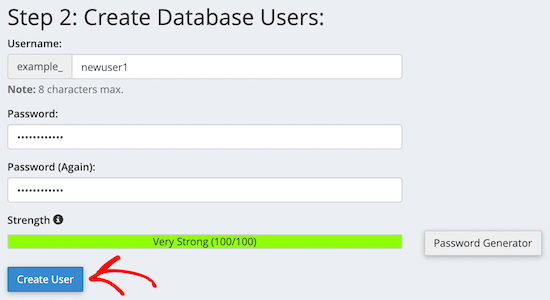
A continuación, tienes que añadir a la base de datos el usuario que acabas de crear.
En primer lugar, haga clic en la casilla de verificación “Todos los privilegios”.
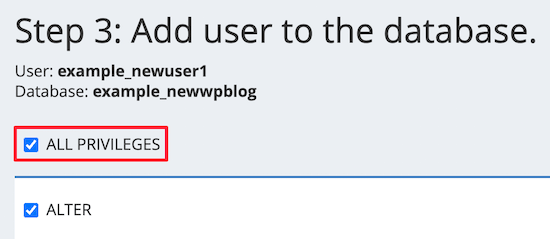
A continuación, desplácese hacia abajo y haga clic en el botón “Realizar cambios” para guardar los cambios.
Su base de datos ya está lista para ser utilizada con su sitio WordPress. Asegúrese de anotar el nombre de la base de datos, el nombre de usuario y la contraseña. Necesitará esta información en el siguiente paso.
Paso 3: Subida de archivos desde el servidor local al sitio web de WordPress.
Ahora tiene que subir los archivos y el instalador de su sitio local a su cuenta de alojamiento.
En primer lugar, conéctese a su sitio activo utilizando un cliente FTP. Una vez conectado, asegúrese de que el directorio raíz de su sitio web está completamente vacío.
Normalmente, el directorio raíz es la carpeta /home/public_html/.
Algunas empresas de alojamiento de WordPress instalan WordPress automáticamente cuando te registras. Si tienes archivos de WordPress allí, entonces necesitas borrarlos.
Después, puede subir los archivos archive.zip e installer.php desde Duplicator a su directorio raíz vacío.

Paso 4: Ejecutar el script de migración
Una vez subidos los archivos de migración, visite la siguiente URL en su navegador / explorador:
http://example.com/installer.php
No olvide sustituir “ejemplo.com” por su propio nombre de dominio.
Se iniciará el asistente de migración de Duplicator.
El instalador realizará algunas pruebas e inicializará el script.
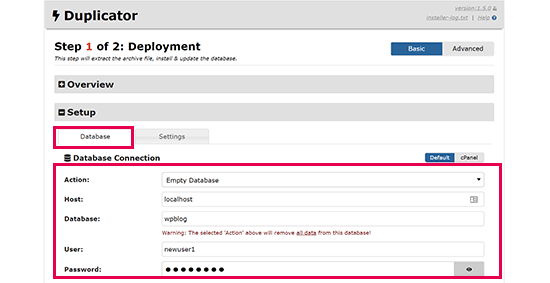
En la sección Configuración, se le pedirá que introduzca su alojamiento MySQL, el nombre de la base de datos, el nombre de usuario y la contraseña.
Su alojamiento será probablemente un alojamiento local. A continuación, introduzca los datos de la base de datos creada en el paso anterior.
A continuación, haga clic en el botón “Validar” para asegurarse de que los datos introducidos son correctos.
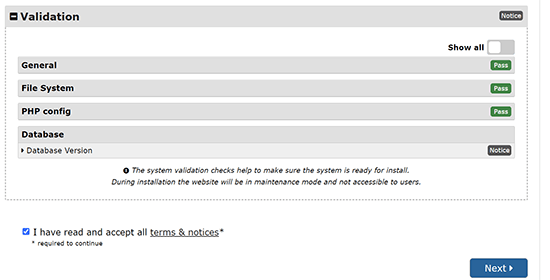
A continuación, haga clic en el botón “Siguiente” para continuar.
Duplicator importará la copia de seguridad de su base de datos de WordPress desde el archivo a su nueva base de datos.
También actualizará las URL que apuntan al sitio local y a su nuevo sitio activo.
Ahora puede hacer clic en el botón ‘Admin Login’ para acceder al área de administrador de WordPress de su sitio.

Una vez que acceda a su sitio activo, Duplicator limpiará automáticamente los archivos de instalación.
Eso es todo. Ha movido correctamente WordPress del servidor local a su sitio activo.
Método 2: Transferir manualmente WordPress del servidor local al sitio activo
En este método, le mostraremos cómo mover manualmente WordPress desde el servidor local a su sitio activo. Será útil si el primer método no funciona o si prefieres hacerlo manualmente.
Paso 1: Exportar la base de datos local de WordPress
Lo primero que tienes que hacer es exportar tu base de datos local de WordPress. Para ello utilizaremos phpMyAdmin.
Si no estás familiarizado con ella, entonces puede que quieras echar un vistazo a nuestra guía para la gestión de bases de datos de WordPress usando phpMyAdmin.
Sólo tienes que ir a http://localhost/phpmyadmin/ y hacer clic en tu base de datos de WordPress. A continuación, haz clic en el botón “Exportar” de la barra de menú superior.

En la opción ‘Método de exportación:’, puede elegir ‘Rápido’ o ‘Personalizado’. Personalizado le proporcionará más opciones para exportar su base de datos.
Pero le recomendamos que elija “Rápido” y luego haga clic en el botón “Ir” para descargar su base de datos.

Paso 2: Subida de archivos de WordPress al sitio activo
Ahora, tendremos que mover todos los archivos de su sitio web al sitio en vivo.
Para empezar, abra su cliente FTP y conéctese a su cuenta de alojamiento web.
Una vez conectado a tu sitio, asegúrate de subir los archivos al directorio correcto. Por ejemplo, si quieres que el sitio esté alojado en ‘tu_sitio.com’, entonces querrás subir todos los archivos a tu directorio public_html.
Ahora seleccione los archivos locales de WordPress y súbalos a su servidor.
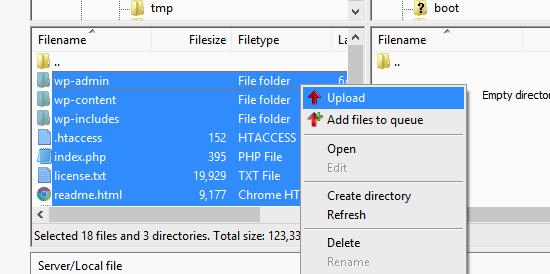
Paso 3: Crear una base de datos MySQL en su sitio activo
Mientras tu cliente FTP está subiendo tus archivos de WordPress, puedes empezar a importar tu base de datos al servidor.
La mayoría de los proveedores de alojamiento de WordPress ofrecen cPanel para gestionar su cuenta de alojamiento, por lo que le mostraremos cómo crear una base de datos utilizando cPanel.
En primer lugar, debe acceder a su panel de control de cPanel y hacer clic en el icono “Asistente para bases de datos MySQL”, que se encuentra en la sección “Bases de datos”.

En la pantalla siguiente, puede crear una nueva base de datos.
Introduzca un nombre para la base de datos y haga clic en “Crear base de datos”.

cPanel creará automáticamente una nueva base de datos para usted.
A continuación, debe introducir un nombre de usuario y una contraseña para su nuevo usuario y, a continuación, hacer clic en “Crear usuario”.
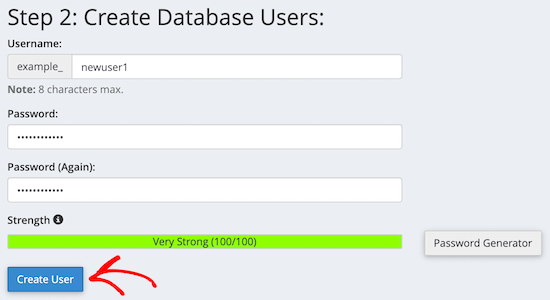
Después, tienes que añadir a la base de datos el usuario que acabas de crear.
En primer lugar, marque / compruebe la casilla de verificación “Todos los privilegios”.
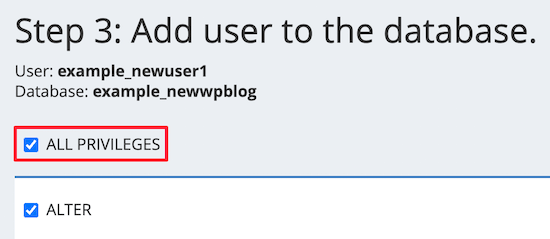
A continuación, desplázate hacia abajo y haz clic en “Realizar cambios” para guardarlos.
Ha creado correctamente una nueva base de datos para su sitio de WordPress.
Paso 4: Importar la base de datos de WordPress al sitio activo
El siguiente paso del proceso es importar su base de datos de WordPress.
Vaya a su Escritorio de cPanel, desplácese hasta la sección ‘Bases de datos’ y haga clic en ‘phpMyAdmin’.
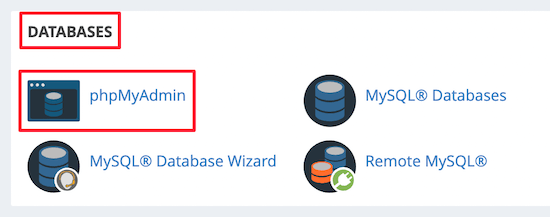
Esto le llevará a phpMyAdmin, donde debe hacer clic en la base de datos que acaba de crear. phpMyAdmin mostrará su nueva base de datos sin tablas.
A continuación, haga clic en la pestaña “Importar” del menú superior. En la página de importación, haga clic en el botón “Elegir archivo” y seleccione el archivo de base de datos del sitio local que guardó en el primer paso.
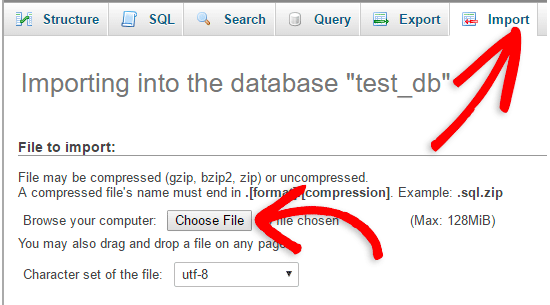
A continuación, haz clic en el botón “Ir” situado en la parte inferior de la página. Tu base de datos se importará automáticamente a phpMyadmin.
Paso 5: Cambiar la URL del sitio
Ahora, usted necesita cambiar la URL del sitio en su base de datos para que se conecte con su sitio de WordPress en vivo.
En phpMyAdmin, busque la tabla wp_options en la base de datos que acaba de importar.
Si ha cambiado el prefijo de su base de datos, entonces en lugar de wp_options, podría ser {new_prefix}_options.
A continuación, haga clic en el botón “Examinar” situado junto a wp_options. O bien, haga clic en el enlace en la barra lateral para abrir la página que tiene un anuncio / catálogo / ficha dentro de la tabla wp_options.
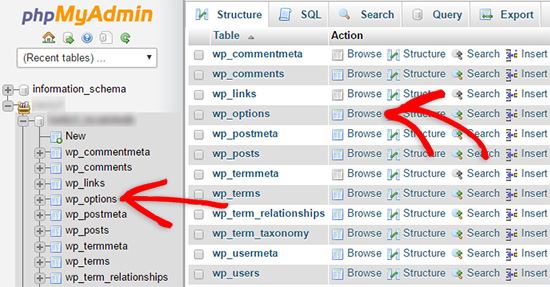
A continuación, en la columna options_name, debe buscar la opción siteurl.
A continuación, haga clic en el icono “Editar”.

Aparecerá una ventana en la que podrá editar el campo.
En el cuadro de entrada option_value, verá la URL de su instalación local, que será algo así como http://localhost/test.
Debe introducir la URL de su nuevo sitio en este campo, por ejemplo: https: //www.wpbeginner.com.
A continuación, puede guardar el campo al hacer clic en el botón “Ir”.
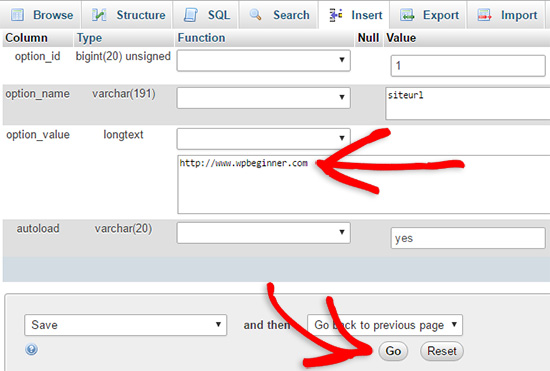
A continuación, debe seguir los mismos pasos anteriores para el nombre de la opción de inicio. El menú wp_options puede tener varias páginas. Normalmente, la opción de inicio estará en la segunda página.
A continuación, actualice la URL de inicio para que sea la misma que la URL de su sitio activo.
Paso 6: Establecer su sitio en vivo
Ahora que ha importado la base de datos y subido su contenido, es el momento de configurar WordPress.
En este momento, su sitio debería mostrar el error“Error al establecer una conexión con la base de datos“.
Para corregirlo, conéctese a su sitio web mediante un cliente FTP y abra el archivo wp-config.php.
Busque las siguientes líneas de código:
1 2 3 4 5 6 7 8 9 | // ** MySQL settings - You can get this info from your web host ** ///** The name of the database for WordPress */define( 'DB_NAME', 'database_name_here' );/** MySQL database username */define( 'DB_USER', 'username_here' );/** MySQL database password */define( 'DB_PASSWORD', 'password_here' );/** MySQL hostname */define( 'DB_HOST', 'localhost' ); |
Deberá indicar el nombre de la base de datos, el nombre de usuario y la contraseña que creó anteriormente.
A continuación, guarde el archivo wp-config.php y vuelva a subirlo al servidor de alojamiento de WordPress.
Ahora, cuando visite su sitio web, debería estar en directo.
Después de eso, tienes que acceder a tu panel de administrador de WordPress e ir a Ajustes ” General. A continuación, sin cambiar nada, desplácese hasta la parte inferior y haga clic en el botón “Guardar cambios”.
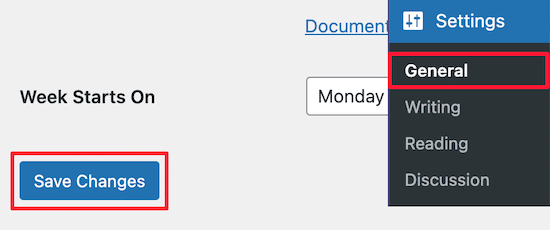
Así se asegurará de que la URL de su sitio se corrige en cualquier otro lugar en el que deba estar.
Una vez hecho esto, vaya a Ajustes ” Enlaces permanentes, desplácese hacia abajo y haga clic en “Guardar cambios” para asegurarse de que todos los enlaces de las entradas funcionan correctamente.

Paso 7: Corregir imágenes y enlaces rotos actualizando rutas
Siempre que traslade un sitio de WordPress de un dominio a otro o de un servidor local a un sitio activo, se encontrará con enlaces rotos e imágenes que faltan.
Le mostraremos dos formas de actualizar las URL. Puede elegir la que más le convenga.
1. Actualizar URLs usando el plugin Search & Replace Everything (Recomendado)
La forma más segura de corregir esto es mediante el uso de Search & Replace Everything. Es un potente plugin de WordPress que le permite realizar fácilmente tareas de actualización por lotes en su sitio web sin necesidad de escribir complejas consultas a la base de datos.
En primer lugar, debe instalar y activar el plugin Search & Replace Everything.
Una vez activado, vaya a la página Herramientas ” WP Search & Replace.
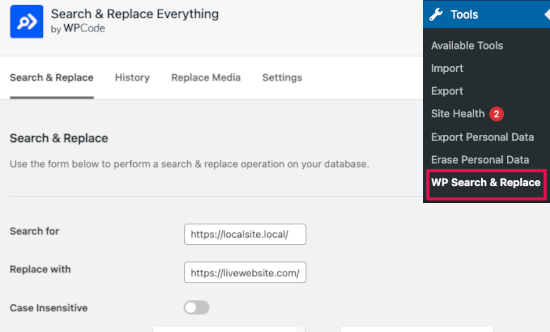
A continuación, introduzca la URL del sitio local en el campo “Buscar” y la URL del sitio activo en el campo “Sustituir por”.
Desplázate un poco y haz clic en “Seleccionar todo” debajo de las tablas. Esto asegura que el plugin buscará la antigua URL en cualquier parte de la base de datos.

Ahora haga clic en el botón “Vista previa de Buscar y reemplazar” para continuar.
El plugin buscará en su base de datos todas las instancias de la URL antigua y previsualizará los resultados.
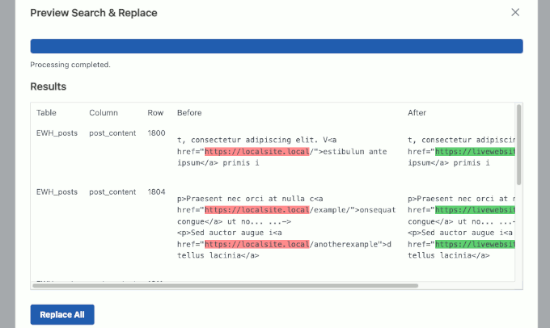
Si todo va bien, haz clic en “Reemplazar todo” para guardar los cambios.
Verás una advertencia acerca de los cambios que estás realizando. Haz clic en “Sí” para continuar.
El plugin actualizará la base de datos y sustituirá las URL locales por la URL actual de su sitio web.
2. Actualizar URL manualmente (Avanzado)
Otra forma de actualizar las URL es mediante la siguiente consulta SQL:
1 | UPDATE wp_posts SET post_content = REPLACE(post_content, 'localhost/test/', 'www.yourlivesite.com/'); |
Simplemente vaya a phpMyAdmin, haga clic en su base de datos y, a continuación, haga clic en “SQL” en el menú superior y añada la consulta anterior.
Asegúrese de cambiarla por la URL de su sitio local y del sitio activo y haga clic en el botón “Ir”.
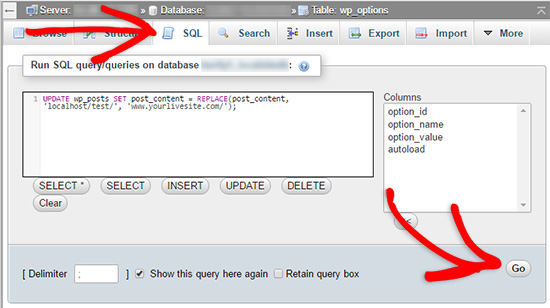
Ya está. Ha migrado correctamente WordPress de su servidor local a un sitio activo.
Esperamos que tu sitio web esté funcionando correctamente. Si usted marca / comprobar cualquier error, puede consultar nuestra guía de errores comunes de WordPress para ayudar a diagnosticar problemas.
Esperamos que este artículo te haya ayudado a trasladar WordPress de un servidor local a un sitio activo. También puedes consultar nuestra guía sobre cómo trasladar un sitio activo a un servidor local o echar un vistazo a la lista de comprobación definitiva para la migración de sitios web para conocer los pasos prácticos de la migración de WordPress.
If you liked this article, then please subscribe to our YouTube Channel for WordPress video tutorials. You can also find us on Twitter and Facebook.




divine
Nice article,
Everything was go fine until the signing up on wordpress Admin, i’ve had d domain name for a long time and I can’t remember my wp-admin login details. What can I do to rectify this problem?
Secondly, I tried visiting my site, it opened but the site kept saying the page could not be found, I need help pls
monica
Hi there,
So, My site is runing and seems to work on the Lovalhost/mysite
DB connection is good, settes permalinks to default.
BUT:
all the links fo to the domain (live site) what I’m missing?
O.o
Thanks in advance, great tuto
rdllngr
Everything worked for me. Thanks a lot!
Alem
Helped me go live Thank you.
Thank you.
aqeel
hi plz help i am having this errer when i click import my database plz help
Error
SQL query:
—
— Database: `testword`
—
— ——————————————————–
—
— Table structure for table `wp_commentmeta`
—
CREATE TABLE IF NOT EXISTS `wp_commentmeta` (
`meta_id` BIGINT( 20 ) UNSIGNED NOT NULL ,
`comment_id` BIGINT( 20 ) UNSIGNED NOT NULL DEFAULT ‘0’,
`meta_key` VARCHAR( 255 ) COLLATE utf8mb4_unicode_ci DEFAULT NULL ,
`meta_value` LONGTEXT COLLATE utf8mb4_unicode_ci
) ENGINE = INNODB DEFAULT CHARSET = utf8mb4 COLLATE = utf8mb4_unicode_ci AUTO_INCREMENT =1;
MySQL said: Documentation
#1046 – No database selected
Prasanna
at the top of everything type USE ;
eg if my database name is wordpress then type
use wordpress;
Ngeshlew
Needless to say, you are the website that I always come to check whenever I want to migrate my local WordPress site to a live server.
Thank you guys for the easy steps.
Wafir Manakad
Hey,
Thanks a lot.
I had two queries:
1. On my new website (destination website), I am copying the old files onto an empty public html folder. That is the way right? There is no need to pre-install wordpress on new site?
2. Everything was fine right until the end. I am moving my website from one domain to another.
Finally when I open the new domain, part of the website loads, and partly there are errors. This is the error message:
Warning: include_once(/home/laprimaa/public_html/wp-content/themes/charlottetheme/charlottetheme/theme/plugin/advanced-customizer/lib/ctAdvancedCustomizerMethods.class.php) [function.include-once]: failed to open stream: No such file or directory in /home/laprimaa/public_html/wp-content/themes/charlottetheme/charlottetheme/framework/createit/ctFilesLoader.class.php on line 143
Does this mean I have not uploaded my files correctly?
Any help would be much appreciated.
Best Regards
sandeep kumar singh
how we can give the link of other page except home . i have given the url of home but by using your tutorial i have added post query but my site is not working till now .so please give me information to resolve this.
Shubhayan Ghoshal
Shouldn’t we be replacing the website name -> localhos/{dirname} for ‘guid’ column rather than post_content column?
justin
Okay everything was sailing smooth until I went to import the new database. Upon trying to import it it only puts in wp_commentmeta, wp_comments, wp_links, wp_options and then spits out the error code: ” #1064 – You have an error in your SQL syntax; check the manual that corresponds to your MySQL server version for the right syntax to use near ‘?’ at line 2 “. Now the whole site is down and I don’t have a clue what the heck it is referring too when it says “line 2”. Line 2 of what? And of course the Manual is so friggin helpful man I’ve never seen such helpful stuff (is there a way to type sarcastically?) Please help…
Frosty
Thanks mate. You are a diamond! Ran into a few problems, mainly 123 reg php address was incorrect but got there in the end.
Many many thanks
kathy
Hi, I am trying to import the database but appear to be getting an error. Any ideas anyone? I’m new to wordpress land.
WPBeginner Support
Can you please only paste the error line?
Admin
kathy
I’ve exported my local database and tried to import and it’s returning the below.
Database: `root_wordpress-trunk`
Table structure for table `wp_comments`
#1046 – No database selected
Any help would be greatly appreciated.
Rob
Hello,
I have migrated my site from local to host server. I followed all steps and everything went right but finnaly, I am missing content (posts, pages etc.). Does anybody has any advice?
Yosifov
Hallo, all worked nice so far, but I reached the step 5 where phpmyAdmin is not giving me the option to edit siteurl and home..
amin
thanks for this tutorial ,
I follow this steps and it work correctly i have domain and hosting from godaddy.
Adeel Ashraf
really awsome work (Y)
kanav
do i need to copy all of my data on a live server with preinstalled wordpress ?
like godaddys managed wordpress ?
WPBeginner Support
Yes.
Admin
Claire
Hello,
I have followed all of the steps above, and everything has gone correctly up until the very last part.
I have edited and uploaded the wp-config.php file and now my webpage is just a blank screen and I have not been able to get into edit it in wordpress. I thought I had lost the whole thing…. I changed the urls in php.myadmin back to local/wordpress and can access it again.
What is going wrong please? Any help appreciated!
Thanks, Claire
WPBeginner Support
Undo the changes you made to wp-config.php you have probably missed something when editing it.
Admin
Katy
Ok I’m having the same problem and I’ve uploaded and reuploaded and changed the wp-config.php file. If I deliberately put in something incorrect it shows error establishing database connection. When I put in the correct information I just get a blank page. Blank page for /wp-admin as well.
Jessica CHu
I’m having this same problem… I’m also not able to get access to wordpress back despite changing the wp-config back to the original settings. Have been through all the instructions step by step. I’m using MAMP and Filezilla on EasySpace… Please help!
Michelle Whittaker
Thank you so much! This was exactly the step-by-step resource I needed! I did get a dB error trying to import the gzipped file but I went back and exported the dB as a zip file and imported into new dB and that worked fine.
Chris Jacobsz
Hi,
Thank you for the excellent article. I am a novice and struggled with Duplicator but got my website up and running by following these instructions step by step. Only one thing, my SQL query to update the broken image links did not work. So I had to do it manually.
Thanks very much.
Chris
Mike
Excellent article!!!
One thing to note: Please be sure you know the SQL host server name before you begin! It took me a little while to figure out that “localhost” in the wp-config.php file needed to be changed to the name of my hosting server.
Everything in the article is spot on and saved me hours of moving my Dev site to my hosted provider….
Arjun
Mike, I am using godaddy and how do I find out my SQL host server name? Currently leaving it as ‘localhost’ in wp-config.php file is not helping. Any help appreciated. Been trying but with no luck.
Maggie Walker
Thank you SO SO SO much for this article!!! I am setting up a WP site for a friend for the first time and it was SO helpful to have this article to walk me through the process of going from local to live! I’m a Front End Dev so the help with all of the PHP, SQL, and FTP was incredibly useful.
darrync
hmm, not working for me.
I went through and did this first time and had problems with php.errors.
So I tried a 2nd time and then i finally got the the ‘Error Establishing Database Connection error’
Then progressed until yes i saw my live site.
However when i click on the login to WP admin on the now live site, it takes me to a directory of wp-admin and the whole WP GUI is not shown!
This leads to me think there was an WP install problem…or..?
Note I am a newbie to WP, PHP, CSS, so please explain as if to talk to a 5yo child please :DDDD
thanks
WPBeginner Support
You need to update WordPress urls. If you can use the admin area then go to Settings > General and make sure you have the URL of your live site in both fields.
Admin
obai and hill
I am following the steps and they are very clear and works well every time.
However, this time i followed the steps and when i reached to step 6 where i will have to set up the WP account, the website worked without giving me the error establishing database connection message.
The problem is i can access the new website wp-admin and the pages redirect me to the testing domain. please help
Dave
Thanks for the article. Very helpful!
I have a question. My current live site (fatcow hosting) is running on a very old version of wordpress. My new local site is ready with the latest of everything. I wanted to create a subdomain and test this new site live on different devises and browsers before actually taking it live.
My question is can I have 2 versions of wordpress running on my hosting site? Will ask the host too, but thought I would ask here as well. So the idea is have my current site which is outdated running while I beta test my new site. Once the new site is all good, then I will replace the old with the current. Good idea? Silly naive thinking from a beginner?
Thanks for any help!
-Dave
Bhaumik Dhandhukia
Thank you very much. My site is live and running.
Shaheryar
Thank you!!!!!!!!!!! Life saver article.
Helped me a lot!!!!!!!!! I did everything step by step. Had to change database names accordingly, had to fix broken links manually but hey, its just small stuff to change which I fixed it quickly.
Really appreciate your time and effort to create such a userful site.
Thanks.
cyberwaver
I did everything mentioned here. Mine is am transferring from one host to another host I followed every step here but my website is still showing blank.
check any help will be appreciated.
Wellbein
Hello . I tried all the process and it seems lie I’m the only one here who s a problem. The problem is the white screen. I can’t troubleshoot because the screen is blank. OMG. I am very sure that I followed the instructions when in fact it isn’t my 1st time to migrate a local site to the live site. What does the white screen means? Please help!!
Don_Kihot
I have developed child theme locally, what are the steps to upload to live server?
WPBeginner Support
Simply upload your child theme folder to /wp-content/themes/ directory on your live site. See our guide on how to create WordPress child theme.
Admin
george
thanks for d dis update, my site uploaded well but d pages are not opening fulling, d post and home page open well but the page just open half well. pls help me
olenyash
Best guide i have been through so far — on everything. Thank you a tonne
Dale Powell
This article has saved my life since the day it was published. Can’t thank you enough
Osama
Great Work !
This Transfer Method Works Good Work
Thank You
Ben
Excellent article. I’ve just followed it step by step for my new business website I’ve been developing on WAMP.
Keep up the great work!
Ben.
Rudra
Really great thanks man
Juan C
THANKS MAN!!!!!
Matthew Eaton
At step 5, I cannot alter the site url or home. It won’t give me the option of editing.
What went wrong?
Chris
There is an icon like “pencil”, you can click that
Adam
When I import all files and database I have error 500 on subpages… Why??
anthony
when I import my database not all of the tables are there. I’m wondering what I’m doing wrong….
Jay Doshi
Firstly You have to select your database(Click on your create database name) and then import your .sql file.
Kailashkumar
Sir i want to upload WordPress site form local host to live server.
Robin
One tip maybe I can help someone with this.
My database from my localserver was far too big to import due to the import limit.
I have used the 7ZIP program to zip my exported database to a gzip file.
This has solved the problem for me.
Thanks for the article! At the moment my website is uploading…
Thijs
Thank you very much for the tutorial. I regret to say that after step 5 everything went blank.
The site is gone and I am not able to recover the information.
I can not believe that creating a simple site can be so difficult.
Robin
Thanks for the info.
Tomorrow I am going to replace my wordpress website. I am reading some people are having issues with the thaccess file. Do I have to change the site adress in this file or not?
Thanks!
Claudio
This was certainly a very helpful tutorial, but why go through such a lengthy process when you can just export and import everything? There might be a couple of things missing like the media library but that’s really easy to download and upload.
I’ve been creating child themes for a while and this what i do for my clients:
– create the whole child theme abs site offline
-once finished simply select expert everything from the settings
-install WordPress on the line host
-select import and point it to the xml file produced before
-that’s it! All your post and pages should be there now
– simply install the cold theme you’ve created and tweak what ever looks “funny”.
I hope this helps.
Aurang Zeb Khan
I am trying since 2 days, “i spend almost full day” but could not succeed. I wanted to try a simple website with only one post so that i could get to know how the whole process will go when i complete my site in the wordpress.
I have done all the steps successfully but when i try to import database to the hosting website an error occurs and i dont know how to solve this. i am using SmartFTP. can anybody help?
Alex Evans
Hi, I understand this process, but can anyone send me a link or tell me the process for taking a locally hosted WP site and uploading it to go live, where there already exists a site on the domain?
For example if I’m creating a new site for someone and now I need the locally hosted site to appear for said domain instead of the hold one.
I’m confused on how DNS works
Raja Asad
Hi ,
please anyone help me out
actually i did all these steps that mentioned above but still couldn’t upload my site form local host to live server
what else i do ?
Asad
Hi ,
i did these all steps but yet i am able to transfer my site from local to c panel
please suggest one thing more is there already word press install on c panel or we have to install it there ?
PAUL
Hi
Thanks for an excellent article – clear, concise, well-illustrated and easy to follow. I’ve been uisng Duplicator for ages, but it just decided – this time – that it wasn’t going to play fair!
Everything worked perfectly until Step 7. The SQL query fixed some, but not all, path changes. I then resorted to the Velvet Blues plugin, which fixed all but one path. I’m still struggling to find a solution for the following:
I have a plugin which utilises its own (two) stylesheets. While Velvet Blues has changed the path to one stylesheet, the other doesn’t want to change. Any ideas how I can effect this manually?
Thanks and regards
Paul (“Webbo”)